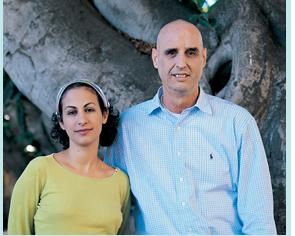The institute's scientists discovered the pathway of transmission, navigation and reception of a communication molecule that plays a key role in the recruitment of stem cells that help damaged tissues

Prof. Zvi Lapidot and research student Ayelet Dar. emergency recruitment
When the body is attacked and threatened, in situations of infection, broken bone, inflammation or chemotherapy, an alarm goes out to the skeleton, asking it to send reinforcements and help the attacked organs and tissues. An important component of this transmitter is, in fact, a small molecule (cytokine), moving from the attacked organ that "transmits" it to the bone marrow that receives it. The bone marrow is located in the center of the bone, and it consists of stem cells that can produce red and white blood cells (which are part of the immune system that protects the body), and cells that produce fat tissue, cartilage, blood vessels and bone.
When the communication molecule reaches the bone marrow, it "recruits" stem cells that help repair the damaged organ or tissue, and immune cells (white blood cells) that protect the damaged area. But how does the communication molecule find its way to the destination? How does it manage to get out of the bloodstream and reach the bone marrow? Prof. Zvi Lapidot and research student Ayelet Dar, from the department of immunology at the Weizmann Institute of Science, and other scientists from the institute, discovered the route of transmission, navigation and reception of the communication molecule, called 1-SDF. The results of their research were recently published in the scientific journal NATURAL IMMUNOLOGY.
It turns out that stationary (non-migratory) tissue cells in the bone marrow and spleen are equipped with a special "antenna", a receptor called CXR4, which is specifically aimed at receiving the 1-SDF molecule. When the message molecule attaches to the receptor molecule, a small vesicle is formed around them which transports them into the cells of the blood vessel wall. 1-SDF continues its journey in the blood vessel wall cells, until it is secreted from their outer side, straight to the bone marrow. The first leg of the journey is complete.
In the next step, the communication molecule attracts migrating stem cells from the bloodstream into the bone marrow, where they divide, multiply, and undergo special training that turns them into skilled immune fighters. At the end of the training, they are released into the bloodstream, where they fulfill their role in protecting the body. But what causes the migrating stem cells to be so strongly attracted to the communication molecule? Prof. Lapidot and the members of his research group, who were looking for an answer to this basic question, discovered to their surprise that stem cells migrating in the bloodstream also display on their membranes the receptor, which is "naturally" displayed on the membranes of stationary tissue cells. This receptor is the "natural partner" of 1-SDF, and the attraction between them resembles a magnetic attraction, which causes the movement of these cells against each other (like taxis).
"Actually," says Prof. Lapidot, "it turns out that the CXR4 receptor works in different ways when it is displayed on the membranes of different cells. A stationary tissue cell, which is equipped with this receptor, wraps the receptor attached to the communication molecule in the vesicle, 'swallows' them, and transfers the communication molecule to the other side of the cell. In contrast, a migrating cell equipped with this receptor cannot insert the communication molecule 1-SDF into the vesicle. Instead, when the receptors of migrating cells bind to the communication molecules, they themselves become more excitable and mobile." In other words, the message of that CXR4 receptor changes according to the context, or according to the identity of the mediator. Borrowing from a completely different world of content, we can say that the medium is the message. Unfortunately, also migrating cancer cells (from breast cancer or prostate cancer tumors), which set out to establish new metastases, are equipped with the CXR4 receptor, which allows them to penetrate into the bone marrow. Prof. Lapidot hopes that future studies will lead to a better understanding of the complex relationship between the receptor and the communication molecule in different types of cells.
Such an understanding may advance the development of ways to strengthen the desired infiltration of normal stem cells into the bone marrow and spleen, and to inhibit the infiltration of cancer cells.
